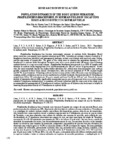Please use this identifier to cite or link to this item:
http://www.alice.cnptia.embrapa.br/alice/handle/doc/1030429| Title: | Population dynamics of the root lesion nematode, Pratylenchus brachyurus, in soybean fields in Tocantins state and its effect to soybean yield. |
| Authors: | LIMA, F. S. de O.  SANTOS, G. R. dos   NOGUEIRA, S. R.   SANTOS, P. R. R. dos   CORREA, V. R.   |
| Affiliation: | Fábia Silva de Oliveira Lima, Instituto Federal de Educação, Ciência e Tecnologia do Tocantins-Campus Dianópolis; Gil Rodrigues dos Santos, Universidade Federal do Tocantins-Campus Gurupi; SONIA REGINA NOGUEIRA, CPAF-AC; Patrícia Resplandes Rocha dos Santos, Universidade Federal do Tocantins-Campus Gurupi; Valdir Ribeiro Correa, Instituto Federal de Educação, Ciência e Tecnologia do Tocantins-Campus Dianópolis. |
| Date Issued: | 2015 |
| Citation: | Nematropica, Florida, v. 45, n. 2, p. 170-177, 2015. |
| Description: | Pratylenchus brachyurus has become increasingly common in soybean fields throughout Brazil where yield loss assessments have reported reduction up to 30%. Currently, no soybean cultivars resistant to P. brachyurus have been identified, and management strategies include crop rotation with non-host crops, fallow, and the application of nematicides. The goals of this study were to examine the population dynamics of P. brachyurus in soybean fields throughout Tocantins state and in areas planted with off-season crops following soybean harvest in a crop succession scheme. Pratylenchus brachyurus was present in ca. 82% of samples with densities in soybean fields ranging from 23 to 20,400 nematodes per 200 cm3 soil or 10 g root samples. In two sites, the mean nematode density was higher within infestation foci, which were characterized by poor soybean growth, compared to those from outside infestation foci, with an overall reduction of 44.3% in plant height and 39.7% in pod numbers. Following soybean harvest in areas planted with off-season crops including maize, sorghum, millet, crotalaria as well as an area maintained as a fallow treatment, the mean density of P. brachyurus ranged from 122 to 504 individuals per 10 g root sample and from 3 to 96 per 200 cm3 soil. Overall, the mean density of nematodes did not differ significantly among plant species and all crops used in the succession scheme allowed P. brachyurus multiplication. In summary, off-season cultivation with the crops used in this study is not recommended for management of P. brachyurus in soybean, but the use of fallow or non-hosts may be helpful in lowering the population density of P. brachyurus in soybean fields. |
| Thesagro: | Soja Glycine max Helminto Nematóide Raiz Pratylenchus brachyurus Dinâmica populacional |
| NAL Thesaurus: | Soybeans Helminths Root lesion nematodes Population dynamics |
| Keywords: | Tocantins Helmintos Dinámica poblacional Nemátodo de las lesiones radiculares Semillas de soja |
| ISSN: | 2220-5616 |
| Type of Material: | Artigo de periódico |
| Access: | openAccess |
| Appears in Collections: | Artigo em periódico indexado (CPAF-AC)  |










